Ultra-Low-Temperature Refrigeration Systems: A Review and Performance Comparison of Refrigerants and Configurations
Abstract
:1. Introduction
2. Refrigerants for Ultra-Low-Temperature Applications
2.1. Natural Working Fluids
2.2. Hydrocarbons
2.3. Mixtures
3. System Configurations
3.1. Single-Stage Vapour Compression Systems
3.2. Multi-Stage Refrigeration Systems
3.3. Cascade Refrigeration Systems
3.4. Auto-Cascade Refrigeration Systems
3.5. Air Refrigeration Cycle
4. Performance Analysis of the Different ULT Refrigeration System Configurations for Various Applications
- The heat losses and pressure drops in the pipes and system components are neglected;
- Steady-state and steady-flow processes are assumed in all components;
- Heat leakages to the external environment are neglected;
- Expansion processes are treated as isenthalpic;
- The power consumption of the pumps is neglected;
- The compressors are non-isentropic, and their efficiencies are expressed as a function of the pressure ratio;
- No superheating or subcooling, and saturated conditions at the heat exchanger outlet;
- The temperature difference in the cascade heat exchanger (CHX) is set to 5 K.
4.1. Model Validation
4.2. Fish Freezing of Mackerel and Cod
- Air blast freezers, which are generally small rooms or tunnels where cold air is blown to freeze the whole fish. Air-cooling coils cool the air;
- Plate freezers, which are typically used for small fish sizes. These consist of hollow plates cooled by refrigerant evaporating inside them, ensuring good contact between the cold surface of the plate and the food. Contrary to air blast freezers, they can only be used to freeze regular-shaped blocks of fish;
- Brine immersion freezing, which can use liquid nitrogen or liquid CO2 and is usually used to quickly freeze a tremendous number of fish by spraying or dipping the fish in the liquid. As a result, the fish quickly cool down to lower temperatures. Extra care is required to protect the fish surface from thermal cracking [54].
- A much higher volumetric refrigeration capacity;
- It always works with positive pressure above the atmospheric one;
- The use of R744 allows for the design of the HTC with a reduced refrigerant charge and, consequently, with a reduction in the costs related to the safety management process;
- Flammable or toxic refrigerants can be used in the primary circuit isolated from the cooling process and storage areas, aiding safety.
4.3. Storage of Mackerel and Cod
- The PAS-30R is used as a design reference for the simulations [32];
- The temperature at the primary cooler outlet is set to 40 °C;
- The turbine and compressor have the same efficiency, which is set to 0.76;
- The effectiveness of the recuperative heat exchanger is equal to 0.95;
- The high-pressure limit in the system is set to 2 bar;
- The circulating air is assumed to be dry;
- There is no air leakage from the system.
4.4. Fish Freezing of Tuna
4.5. Storage of Tuna
4.6. Vaccine Storage/Medical Applications
4.7. Gas Pre-Cooling
4.8. Detector Cooling
5. Further Considerations Regarding Storage Applications
- For the ARC, the assumptions previously presented are still valid;
- For the MRS and CRS, the same assumptions are used as before;
- The heat rejection temperature is set to 30 °C;
- The optimisation procedure of the high-pressure (ARC), intermediate-pressure (MRS), and gas-cooler-pressure (R744) condensing temperatures of the LTC (CRS) has been carried out;
- The temperature difference between the refrigerant evaporating and the air in the cold room is set to 5 K (MRS, CRS), while for the ARC, it is a result of the simulation;
- For the MRS, the refrigerants R717 and R744 have been considered, while for the CRS, different refrigerant pairs were included in the simulation, such as R717/R744, R290/R744, R717/R170, R290/R170, and R290/R1150.
- For an MRS operating with R717, only for an evaporating temperature of −35 °C is the discharge temperature limit not exceeded;
- For lower evaporating temperatures, the discharge temperature exceeds the limit, and therefore the optimal intermediate pressure obtained in the first simulation run is used as an input for subsequent simulations;
- The assumption above is valid for a small temperature range in the warehouse, as seen in the shortened curve (green dotted line). This is mainly linked to the following consideration: Keeping the discharge temperature of the HT compressor under control causes a deterioration in the discharge temperature in the LT stage. The discharge temperature limit is exceeded in the LT stage;
- For R744, the range of applicability remains unchanged, and only a deterioration in the COP has been noticed because of the negative effect of the superheat.
- For the CRS, the following conclusions are drawn:
- For the refrigerant pair R717/R744, one constant LT condensing temperature is used to limit the discharge temperature in the HTC. The superheat reduces the compressor’s capacity and increases the discharge temperature, reducing the COP (Figure 20) due to the constant condensing temperature in the LTC (around −1.4 °C). A decreased evaporating temperature results in a decreased optimal condensing temperature, implying a further deterioration in the energy performance;
- For R290/R744, no issues have been recorded, promoting its implementation in the evaporating temperature region between −35 and −50 °C. It can also be noticed that the COP curve of the CRS working with the refrigerant pair R717/R744 starts to detach from the upper curve of R290/R744. This can be explained by the high energy losses that occur in the ammonia circuit. The superheating losses strongly influence R717, and therefore including the superheating induces a faster deterioration of the COP;
- The optimisation procedure presents the same issues described above for the refrigerant pair R717/R170 used for storage purposes at lower temperatures. Thus, the condensing temperature has been defined to maintain the discharge temperature below the limit of 120 °C. Considering the superheating, the range of applicability of such a refrigerant pair is shortened, and where it can be used, the COP undergoes a sharp decrease. For lower evaporating temperatures (above the NBP of ethane), the use of R290 is recommended. Another choice may be an azeotropic mixture to attain the best heat transfer;
- For the pair R290/R1150, the condensing temperature has been chosen according to the limit in the pressure ratio on both sides. At extremely low temperatures, the LTC shows a pressure ratio close to 12, and the compressor efficiencies are excessively low, leading to poor COP values. In this scenario, a CRS with a two-stage layout on the upper cycle can solve these issues, attaining better efficiency and promoting the system, even in warmer climates. The disadvantages are the investment costs and the additional heat exchangers involved in the system.
6. Conclusions
- For freezing mackerel/cod from 0 to −40 °C, a CRS working with R717 in the HTC and R744 in the LTC (COP ~1.9) is suggested, considering the applicability;
- For the onboard storage of cod/mackerel at −30 °C, an MRS or CRS is used. A good, non-flammable option is using a CRS with R717 in the HTC and R744 in the LTC with a COP of about 2.5 (a condensing temperature of 15 °C). An ARC was analysed, resulting in a COP of about 0.55. In this temperature area, ARCs are not competitive with other systems;
- The CRS is the most efficient system for freezing tuna from −20 to −60 °C using HCs in both cycles (the HTC and LTC). R290 or R1270 for the HTC and R170 or R1150 for the LTC are the best-performing solutions, with COPs of about 1, also taking the discharge temperature of the HTC into account. Similar COPs can be recorded using R744a in the LT stage, but its use requires further studies on its stability. Great interest should be given to the R744 and R744A pair (COP ~0.9), which has a very good volumetric refrigeration capacity and is almost climate-neutral;
- For storing tuna at −60 °C, a CRS with the refrigerant pair R1270 (HTC)/R170 (LTC) or R290 (HTC)/R170 (LTC) results in the best COP (COP ~1.4). A distinction is made whether it is on- or offshore storage that is needed. For onshore storage, the ARC is a good option (COP ~ 0.4). A CRS using R290 as the HTC refrigerant and R744/R1150 or R744/R170 as the LTC mixture gives a COP of 1.2/1.3. Using a mixture as the LTC refrigerant lowers the COP but shows beneficial properties, such as non-flammability, if the suitable composition is chosen;
- Pfizer vaccines are stored at −70 °C. A CRS (large capacities) or ACR (small capacities) is used, depending on the required cooling capacity. An ARC is also very interesting for large capacities due to its significant advantages at this temperature level. At a warehouse temperature of −70 °C, the COP of an ARC is about 0.4;
- LNG pre-cooling is performed via a CRS using mixtures as refrigerants. The cascade system with mixtures can improve the efficiency by matching the temperature glides, which can be adjusted according to the requirements of the gas-processing unit by altering their compositions. The highest glide is achieved with R1150/R600, and the lowest is achieved with R170/R290. For the HTC, R290 possesses the best potential, and for the LTC, the highest COP is achieved with the R170/R600 mixture;
- For the detector-cooling process, specific requirements, such as radiation, space limitation, and the absence of oil, are needed for the refrigerant and system configuration. This results in a CRS with R744 as a suitable refrigerant in both cycles;
- The deep analysis conducted on storage applications revealed the importance of defining the real compressors’ efficiencies considering several aspects, such as the refrigerant, pressure ratio, and superheating degree at the suction port.
Author Contributions
Funding
Data Availability Statement
Conflicts of Interest
Nomenclatures
| ACR | Auto-cascade refrigeration system |
| ARC | Air refrigeration cycle |
| AREP | Alternative Refrigerants Evaluation Program |
| ASHRAE | American Society of Heating, Refrigeration and Air-Conditioning Engineers |
| CAPEX | Capital expenditure |
| CERN | European Organisation for Nuclear Research |
| CFC | Chlorofluorocarbon |
| CHX | Cascade heat exchanger |
| COP | Coefficient of performance |
| cond | Condenser |
| CRS | Cascade refrigeration system |
| EES | Engineering Equation Solver |
| EU | European Union |
| evap | Evaporator |
| GWP | Global warming potential |
| HCFCs | Hydrochlorofluorocarbons |
| HCs | Hydrocarbons |
| HFCs | Hydrofluorocarbons |
| HT | High temperature |
| HTC | High-temperature circuit |
| LHC | Large Hadron Collider |
| LNG | Liquefied natural gas |
| LT | Low temperature |
| LTC | Low-temperature cycle |
| MRS | Multi-stage refrigeration system |
| NBP | Normal boiling point |
| ODP | Ozone depletion potential |
| PAG | Polyalkylene |
| PAO | Polyalphaolefin |
| POE | Polyolester |
| RSW | Refrigerated seawater |
| T | Temperature (°C) |
| ULT | Ultra-low temperature |
| VRC | Vapor compression refrigeration system |
References
- ASHRAE. Handbook-Refrigeration; American Society of Heating Refrigerating and Air-Conditioning Engineers: Atlanta, GA, USA, 2018. [Google Scholar]
- European Commission EU Legislation to Control F-Gases. Available online: https://climate.ec.europa.eu/eu-action/fluorinated-greenhouse-gases/eu-legislation-control-f-gases_en (accessed on 10 May 2021).
- European Environment Agency Hydrofluorocarbon Phase-Down in Europe. Available online: https://www.eea.europa.eu/ims/hydrofluorocarbon-phase-down-in-europe (accessed on 10 May 2021).
- Mota-Babiloni, A.; Mastani Joybari, M.; Navarro-Esbrí, J.; Mateu-Royo, C.; Barragán-Cervera, Á.; Amat-Albuixech, M.; Molés, F. Ultralow-temperature refrigeration systems: Configurations and refrigerants to reduce the environmental impact. Int. J. Refrig. 2020, 111, 147–158. [Google Scholar] [CrossRef]
- Sharma, V.; Fricke, B.; Bansal, P. Comparative analysis of various CO2 configurations in supermarket refrigeration systems. Int. J. Refrig. 2014, 46, 86–99. [Google Scholar] [CrossRef]
- Kruse, H.; Rüssmann, H. The natural fluid nitrous oxide—An option as substitute for low temperature synthetic refrigerants. Int. J. Refrig. 2006, 29, 799–806. [Google Scholar] [CrossRef]
- Rodríguez-Jara, E.Á.; Sánchez-de-la-Flor, F.J.; Expósito-Carrillo, J.A.; Salmerón-Lissén, J.M. Thermodynamic analysis of auto-cascade refrigeration cycles, with and without ejector, for ultra low temperature freezing using a mixture of refrigerants R600a and R1150. Appl. Therm. Eng. 2022, 200, 117598. [Google Scholar] [CrossRef]
- Torrella, E.; Larumbe, J.A.; Cabello, R.; Llopis, R.; Sanchez, D. A general methodology for energy comparison of intermediate configurations in two-stage vapour compression refrigeration systems. Energy 2011, 36, 4119–4124. [Google Scholar] [CrossRef]
- Baakeem, S.S.; Orfi, J.; Alabdulkarem, A. Optimization of a multistage vapor-compression refrigeration system for various refrigerants. Appl. Therm. Eng. 2018, 136, 84–96. [Google Scholar] [CrossRef]
- Cabello, R.; Torrella, E.; Llopis, R.; Sánchez, D. Comparative evaluation of the intermediate systems employed in two-stage refrigeration cycles driven by compound compressors. Energy 2010, 35, 1274–1280. [Google Scholar] [CrossRef]
- Agrawal, N.; Bhattacharyya, S. Studies on a two-stage transcritical carbon dioxide heat pump cycle with flash intercooling. Appl. Therm. Eng. 2007, 27, 299–305. [Google Scholar] [CrossRef]
- Pan, M.; Zhao, H.; Liang, D.; Zhu, Y.; Liang, Y.; Bao, G. A Review of the Cascade Refrigeration System. Energies 2020, 13, 2254. [Google Scholar] [CrossRef]
- Kumar Singh, K.; Kumar, R.; Gupta, A. Comparative energy, exergy and economic analysis of a cascade refrigeration system incorporated with flash tank (HTC) and a flash intercooler with indirect subcooler (LTC) using natural refrigerant couples. Sustain. Energy Technol. Assess. 2020, 39, 100716. [Google Scholar] [CrossRef]
- Udroiu, C.-M.; Mota-Babiloni, A.; Giménez-Prades, P.; Barragán-Cervera, Á.; Navarro-Esbrí, J. Thermodynamic evaluation of CO2 for ultra-low temperature refrigeration. Energy Convers. Manag. X 2023, 20, 100446. [Google Scholar] [CrossRef]
- Du, K.; Zhang, S.; Xu, W.; Niu, X. A study on the cycle characteristics of an auto-cascade refrigeration system. Exp. Therm. Fluid Sci. 2009, 33, 240–245. [Google Scholar] [CrossRef]
- Yan, G.; Hu, H.; Yu, J. Performance evaluation on an internal auto-cascade refrigeration cycle with mixture refrigerant R290/R600a. Appl. Therm. Eng. 2015, 75, 994–1000. [Google Scholar] [CrossRef]
- Hao, X.; Wang, L.; Wang, Z.; Tan, Y.; Yan, X. Hybrid auto-cascade refrigeration system coupled with a heat-driven ejector cooling cycle. Energy 2018, 161, 988–998. [Google Scholar] [CrossRef]
- Qin, Y.; Li, N.; Zhang, H.; Liu, B. Energy and exergy performance evaluation of a three-stage auto-cascade refrigeration system using low-GWP alternative refrigerants. Int. J. Refrig. 2021, 126, 66–75. [Google Scholar] [CrossRef]
- Aprea, C.; Maiorino, A. Autocascade refrigeration system: Experimental results in achieving ultra low temperature. Int. J. Energy Res. 2009, 33, 565–575. [Google Scholar] [CrossRef]
- Asgari, S.; Noorpoor, A.R.; Boyaghchi, F.A. Parametric assessment and multi-objective optimization of an internal auto-cascade refrigeration cycle based on advanced exergy and exergoeconomic concepts. Energy 2017, 125, 576–590. [Google Scholar] [CrossRef]
- Giannetti, N.; Milazzo, A. Thermodynamic analysis of regenerated air-cycle refrigeration in high and low pressure configuration. Int. J. Refrig. 2014, 40, 97–110. [Google Scholar] [CrossRef]
- Zhang, Z.; Liu, S.; Tian, L. Thermodynamic analysis of air cycle refrigeration system for Chinese train air conditioning. Syst. Eng. Procedia 2011, 1, 16–22. [Google Scholar] [CrossRef]
- Gigiel, A.; Giuliani, G.; Vitale, C.; Polonara, F. An open air cycle freezer. In Proceedings of the 7th IIR Gustav Lorentzen Conference on Natural Working Fluids, Trondheim, Norway, 29–31 May 2006; pp. 325–328. [Google Scholar]
- Kikuchi, S.; Dore, M.P. Epidemiology of Helicobacter pylori Infection. Helicobacter 2005, 10, 1–4. [Google Scholar] [CrossRef]
- Mirai Mirai Cold Products, Open and Closed Cycle for Air Refrigeration. Available online: https://mirai-intex.com/products (accessed on 8 September 2021).
- Mayekawa Ultra-Low Temperature Air Refrigeration System Pascal-Air. Available online: https://www.mayekawa.com.au/products/pascal-air/ (accessed on 8 September 2021).
- Klein, S.A. Engineering Equation Solver (EES), F-Chart Software, Madison, USA. Available online: https://fchartsoftware.com/ees/index.php/ (accessed on 7 April 2021).
- Mumanachit, P.; Reindl, D.T.; Nellis, G.F. Comparative analysis of low temperature industrial refrigeration systems. Int. J. Refrig. 2012, 35, 1208–1221. [Google Scholar] [CrossRef]
- Lee, T.-S.; Liu, C.-H.; Chen, T.-W. Thermodynamic analysis of optimal condensing temperature of cascade-condenser in CO2/NH3 cascade refrigeration systems. Int. J. Refrig. 2006, 29, 1100–1108. [Google Scholar] [CrossRef]
- Niu, X.-D.; Yamaguchi, H.; Iwamoto, Y.; Nekså, P. Experimental study on a CO2solid–gas-flow-based ultra-low temperature cascade refrigeration system. Int. J. Low-Carbon Technol. 2011, 6, 93–99. [Google Scholar] [CrossRef]
- Sobieraj, M.; Rosiński, M. High phase-separation efficiency auto-cascade system working with a blend of carbon dioxide for low-temperature isothermal refrigeration. Appl. Therm. Eng. 2019, 161, 114149. [Google Scholar] [CrossRef]
- Boone, J.; Machida, A. Development of air refrigeration system “Pascal Air”. In Proceedings of the 23rd International Congress of Refrigeration, Prague, Czech Republic, 21–26 August 2011; pp. 1597–1605. [Google Scholar]
- Harby, K. Hydrocarbons and their mixtures as alternatives to environmental unfriendly halogenated refrigerants: An updated overview. Renew. Sustain. Energy Rev. 2017, 73, 1247–1264. [Google Scholar] [CrossRef]
- Rajapaksha, L. Influence of special attributes of zeotropic refrigerant mixtures on design and operation of vapour compression refrigeration and heat pump systems. Energy Convers. Manag. 2007, 48, 539–545. [Google Scholar] [CrossRef]
- Zhao, Y.; Li, Z.; Zhang, X.; Wang, X.; Dong, X.; Gao, B.; Gong, M.; Shen, J. Azeotropic refrigerants and its application in vapor compression refrigeration cycle. Int. J. Refrig. 2019, 108, 1–13. [Google Scholar] [CrossRef]
- Mohanraj, M.; Muraleedharan, C.; Jayaraj, S. A review on recent developments in new refrigerant mixtures for vapour compression-based refrigeration, air-conditioning and heat pump units. Int. J. Energy Res. 2011, 35, 647–669. [Google Scholar] [CrossRef]
- Lemmon, E.W.; Huber, M.L.; McLinden, M.O.; Bell, I. NIST Standard Reference Database 23: Reference Fluid Thermodynamic and Transport Properties-REFPROP, Version 10.0; National Institute of Standards and Technology: Gaithersburg, MD, USA, 2020.
- Linde Refrigeration: Processes & Temperatures. Selecting the Best Refrigerant Gas for Your Process Temperature Requirements. Available online: https://www.linde-gas.com/en/processes/refrigeration_and_air_conditioning/refrigeration_processes_and_temperatures/index.html (accessed on 5 May 2021).
- Bai, T.; Li, D.; Xie, H.; Yan, G.; Yu, J. Experimental research on a Joule-Thomson refrigeration cycle with mixture R170/R290 for− 60 °C low-temperature freezer. Appl. Therm. Eng. 2021, 186, 116476. [Google Scholar] [CrossRef]
- Ahammed, M.E.; Bhattacharyya, S.; Ramgopal, M. Thermodynamic design and simulation of a CO2 based transcritical vapour compression refrigeration system with an ejector. Int. J. Refrig. 2014, 45, 177–188. [Google Scholar] [CrossRef]
- Chakravarthy, V.S.; Shah, R.K.; Venkatarathnam, G. A Review of Refrigeration Methods in the Temperature Range 4–300 K. J. Therm. Sci. Eng. Appl. 2011, 3, 020801. [Google Scholar] [CrossRef]
- Llopis, R.; Nebot-Andrés, L.; Sánchez, D.; Catalán-Gil, J.; Cabello, R. Subcooling methods for CO2 refrigeration cycles: A review. Int. J. Refrig. 2018, 93, 85–107. [Google Scholar] [CrossRef]
- Nasution, A.; Ambarita, H.; Sihombing, H.; Setiawan, E.; Kawai, H. The Effect of Stage Number on the Performance of a Vapor Compression Refrigeration Cycle Using Refrigerant R32; IOP Conference Series: Materials Science and Engineering; IOP Publishing: Bristol, UK, 2020. [Google Scholar]
- Jiang, S.; Wang, S.; Jin, X.; Zhang, T. A general model for two-stage vapor compression heat pump systems. Int. J. Refrig. 2015, 51, 88–102. [Google Scholar] [CrossRef]
- Adamson, B. Application of Hydrocarbon Refrigerants in Low Temperature Cascade Systems. In Proceedings of the 7th IIR Gustav Lorentzen Conference on Natural Working Fluids, Trondheim, Norway, 29–31 May 2006; Refrigeration Engineering Pty Ltd.: Unanderra, Australia, 2006. [Google Scholar]
- Xu, X.; Liu, J.; Cao, L. Mixed refrigerant composition shift due to throttle valves opening in auto cascade refrigeration system. Chin. J. Chem. Eng. 2015, 23, 199–204. [Google Scholar] [CrossRef]
- Liu, Y.; Yu, J. Performance evaluation of an ejector subcooling refrigeration cycle with zeotropic mixture R290/R170 for low-temperature freezer applications. Appl. Therm. Eng. 2019, 161, 114128. [Google Scholar] [CrossRef]
- Bai, T.; Yan, G.; Yu, J. Experimental investigation of an ejector-enhanced auto-cascade refrigeration system. Appl. Therm. Eng. 2018, 129, 792–801. [Google Scholar] [CrossRef]
- Liu, J.; Liu, Y.; Yu, J.; Yan, G. Thermodynamic analysis of a novel ejector-enhanced auto-cascade refrigeration cycle. Appl. Therm. Eng. 2022, 200, 117636. [Google Scholar] [CrossRef]
- Bellos, E.; Tzivanidis, C. A Theoretical Comparative Study of CO2 Cascade Refrigeration Systems. Appl. Sci. 2019, 9, 790. [Google Scholar] [CrossRef]
- Bellos, E.; Tzivanidis, C. A comparative study of CO2 refrigeration systems. Energy Convers. Manag. X 2019, 1, 100002. [Google Scholar] [CrossRef]
- Alberto Dopazo, J.; Fernández-Seara, J.; Sieres, J.; Uhía, F.J. Theoretical analysis of a CO2–NH3 cascade refrigeration system for cooling applications at low temperatures. Appl. Therm. Eng. 2009, 29, 1577–1583. [Google Scholar] [CrossRef]
- Hafner, I.A.; Gabrielii, C.; Widell, K. Refrigeration Units in Marine Vessels: Alternatives to HCFCs and High GWP HFCs; Nordic Council of Ministers: Copenhagen, Denmark, 2019. [Google Scholar]
- Airah, M. Carbon Dioxide (CO2) for the Food Processing and Cold Storage Industries. 2002. Available online: https://www.semanticscholar.org/paper/CARBON-DIOXIDE-(CO2)-FOR-THE-FOOD-PROCESSING-AND-Airah/e29fe13c23eabeebebdff039cc4fb906e30589f9#citing-papers (accessed on 6 October 2021).
- Söylemez, E.; Widell, K.N.; Gabrielii, C.H.; Ladam, Y.; Lund, T.; Hafner, A. Overview of the development and status of carbon dioxide (R-744) refrigeration systems onboard fishing vessels. Int. J. Refrig. 2022, 140, 198–212. [Google Scholar] [CrossRef]
- Sawalha, S. Carbon Dioxide in Supermarket Refrigeration. Ph.D. Thesis, KTH, Stockholm, Sweden, 2008. [Google Scholar]
- Llopis, R.; Sánchez, D.; Sanz-Kock, C.; Cabello, R.; Torrella, E. Energy and environmental comparison of two-stage solutions for commercial refrigeration at low temperature: Fluids and systems. Appl. Energy 2015, 138, 133–142. [Google Scholar] [CrossRef]
- Di Nicola, G.; Polonara, F.; Stryjek, R.; Arteconi, A. Performance of cascade cycles working with blends of CO2 + natural refrigerants. Int. J. Refrig. 2011, 34, 1436–1445. [Google Scholar] [CrossRef]
- Kauffeld, M.; Maurath, T.; Germanus, J.; Askar, E. N2O/CO2-Mixtures as Refrigerants for Temperatures below −50 °C. Int. J. Refrig. 2020, 117, 316–327. [Google Scholar] [CrossRef]
- Refolution Industriekalte Efficiency Comparison of Refrigeration Technologies for Ultra-Low Temperature (ULT) Applications between −40 °C and −110 °C. Available online: https://3f74e260-dfd4-47ca-9b8e-d224d67a4b12.filesusr.com/ugd/dc61a9_97e8adedbd4f43a5b0bfff1c800cc267.pdf?index=true (accessed on 6 June 2021).
- Santos, A.F.; Gaspar, P.D.; de Souza, H.J.L. Refrigeration of COVID-19 Vaccines: Ideal Storage Characteristics, Energy Efficiency and Environmental Impacts of Various Vaccine Options. Energies 2021, 14, 1849. [Google Scholar] [CrossRef]
- Yan, G.; He, C.; Yu, J. Theoretical investigation on the performance of a modified refrigeration cycle using binary zeotropic hydrocarbon mixture R170/R290. Int. J. Refrig. 2018, 94, 111–117. [Google Scholar] [CrossRef]
- Castillo, L.; Majzoub Dahouk, M.; Di Scipio, S.; Dorao, C.A. Conceptual analysis of the precooling stage for LNG processes. Energy Convers. Manag. 2013, 66, 41–47. [Google Scholar] [CrossRef]
- Castillo, L.; Dorao, C.A. On the conceptual design of pre-cooling stage of LNG plants using propane or an ethane/propane mixture. Energy Convers. Manag. 2013, 65, 140–146. [Google Scholar] [CrossRef]
- Bhanot, V.; Dhumane, R.; Petagna, P.; Cioncolini, A.; Iacovides, H.; Ling, J.; Aute, V. Development of a Numerical Tool for Dynamic Simulations of Two-Phase Cooling Systems. Int. J. Simul. Model. 2019, 18, 302–313. [Google Scholar] [CrossRef]
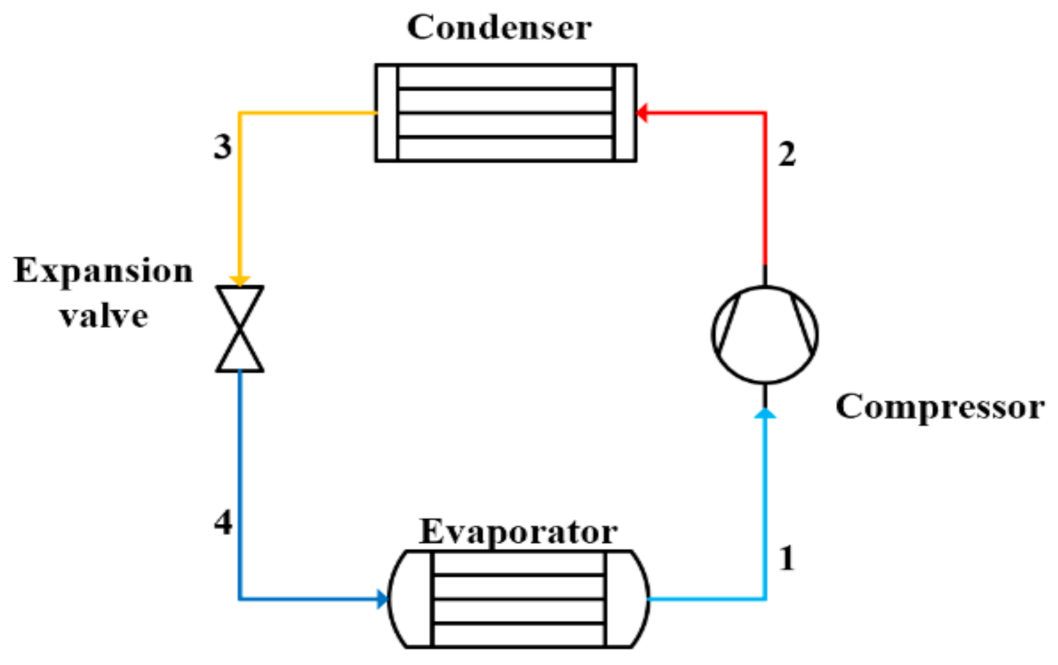



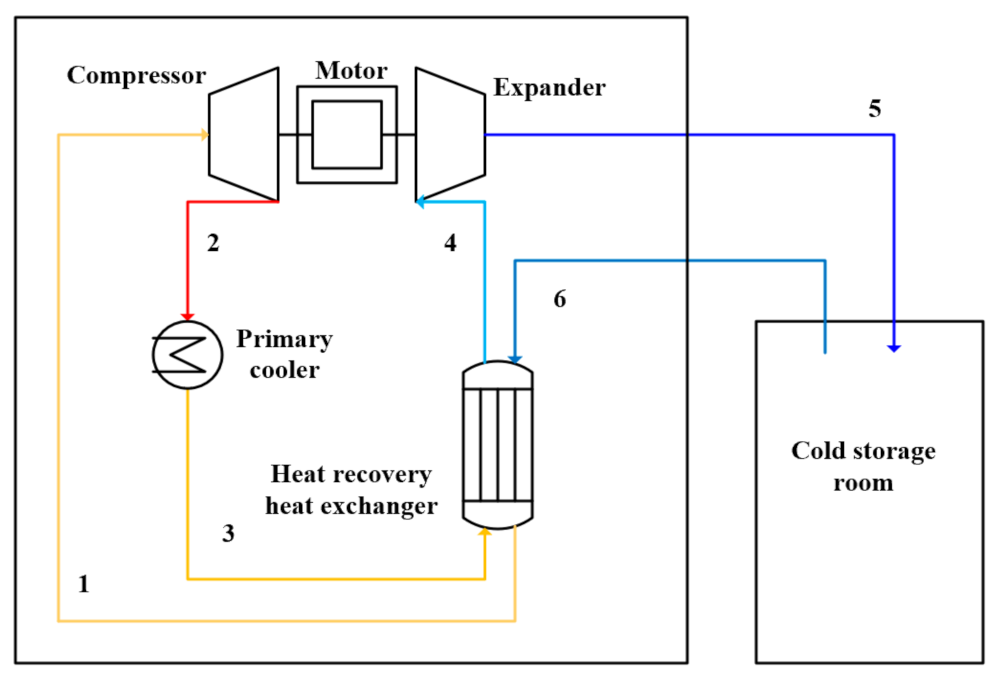

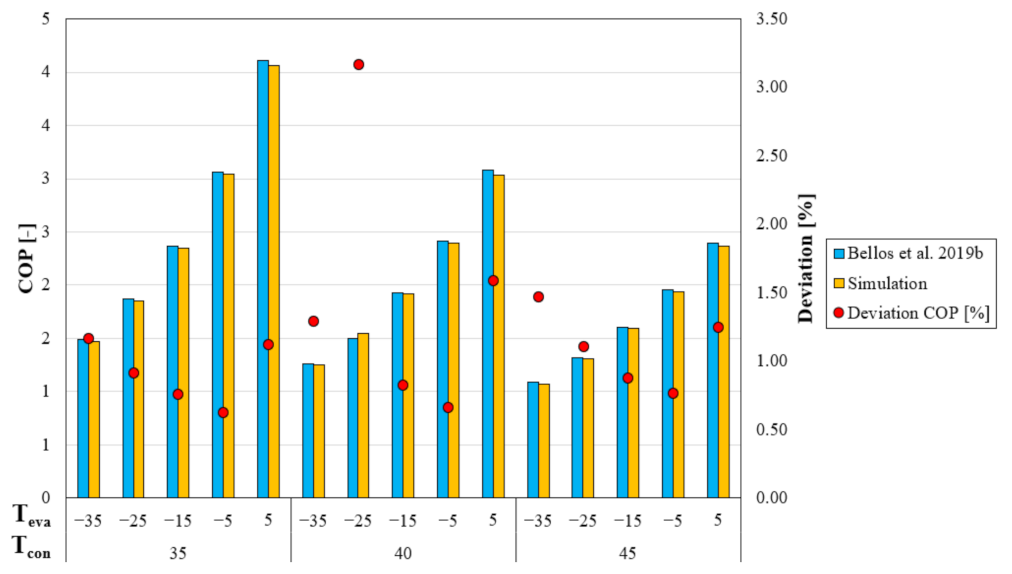
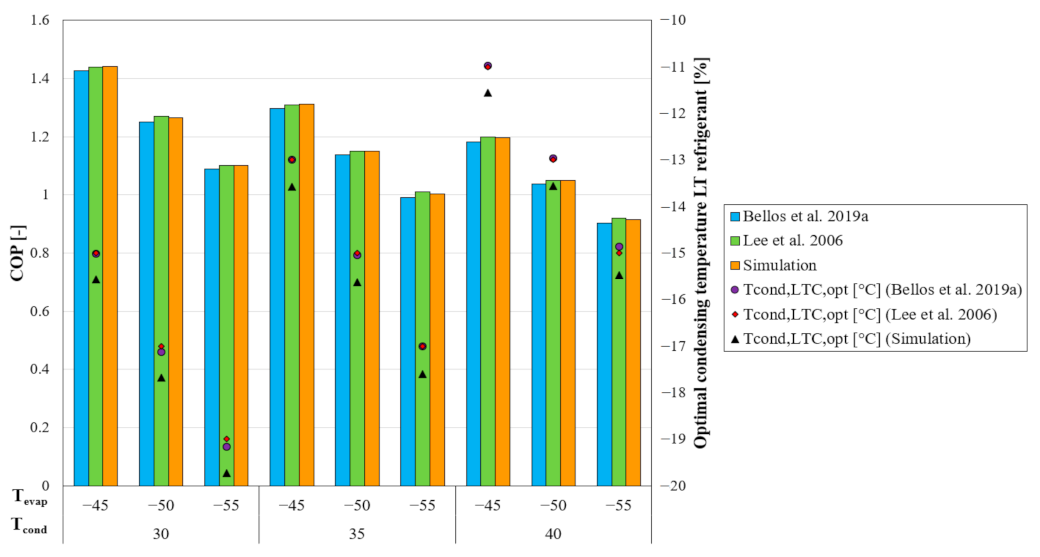
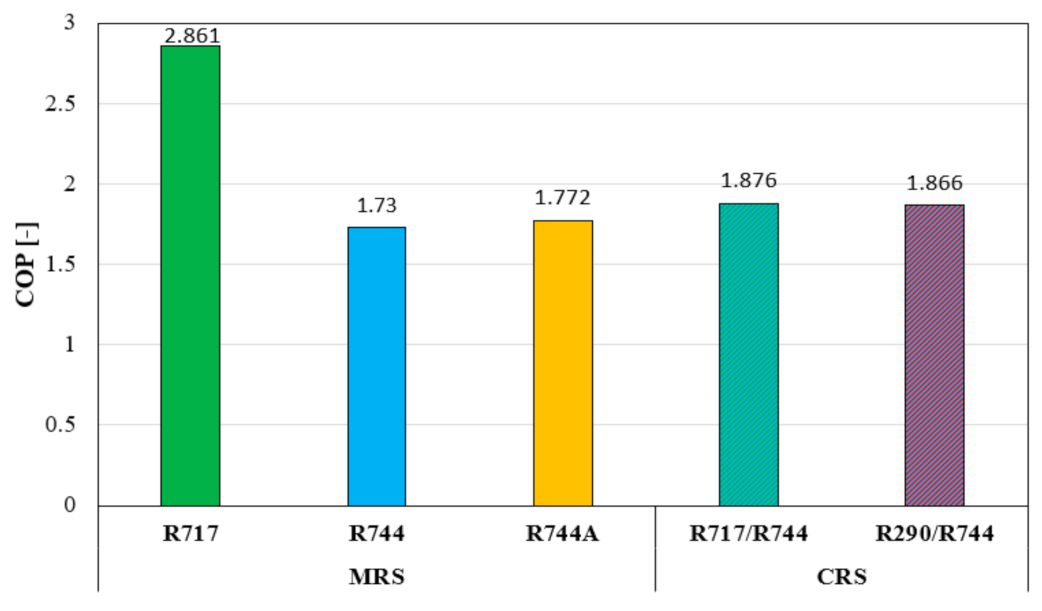

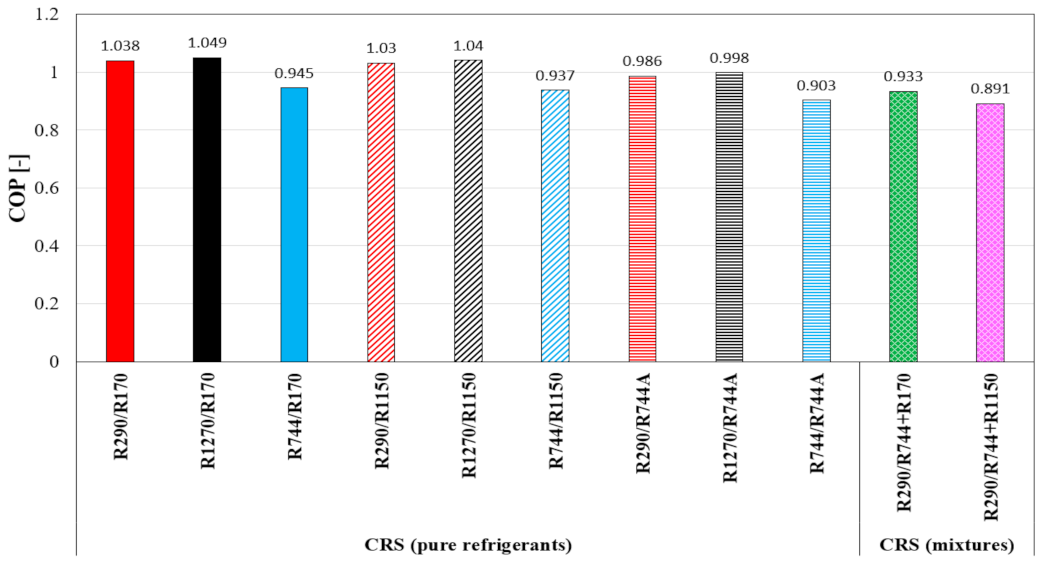
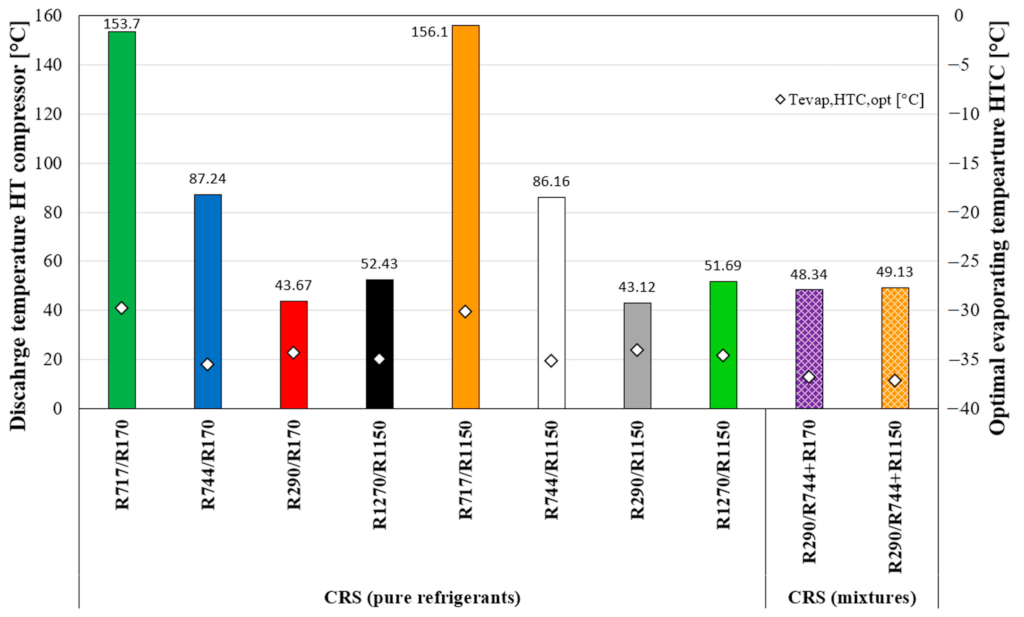
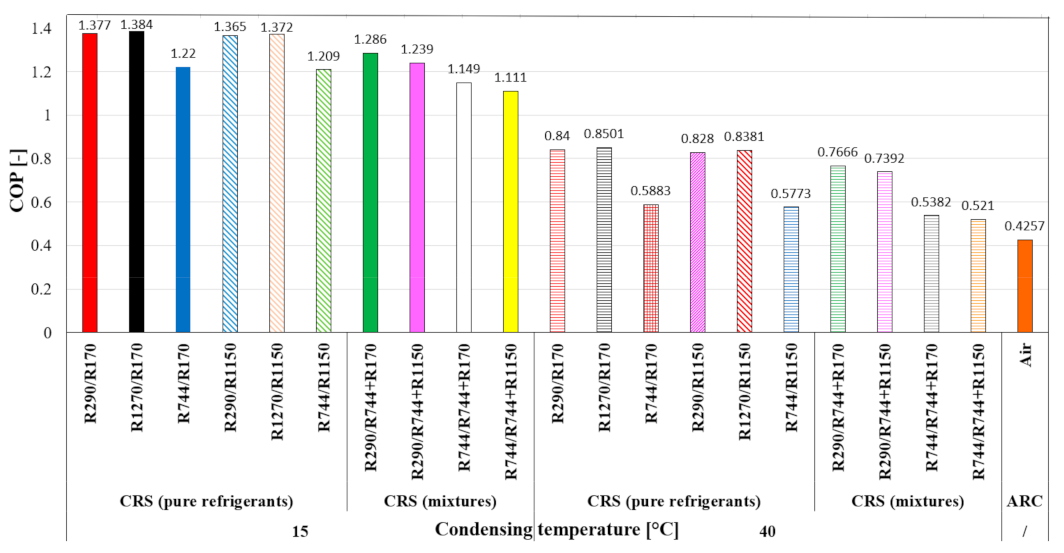



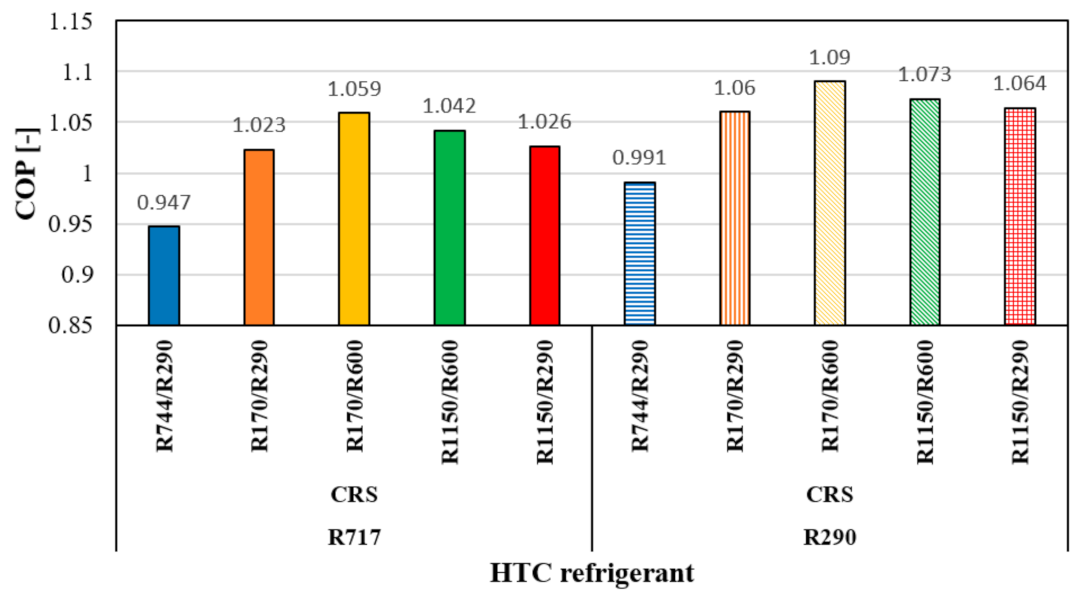
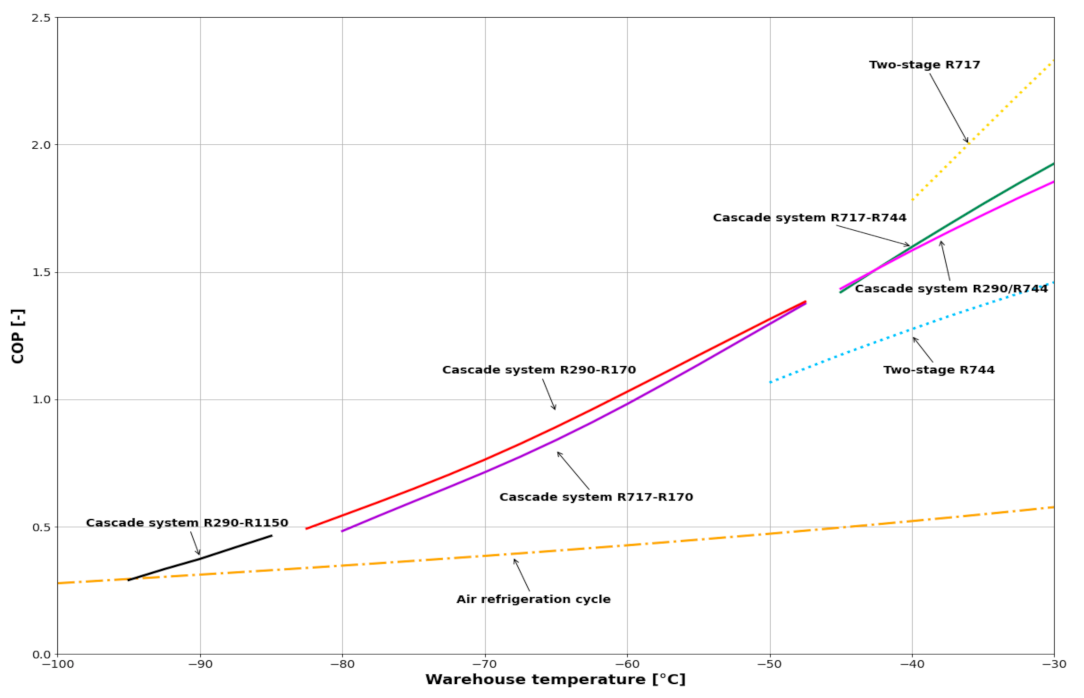
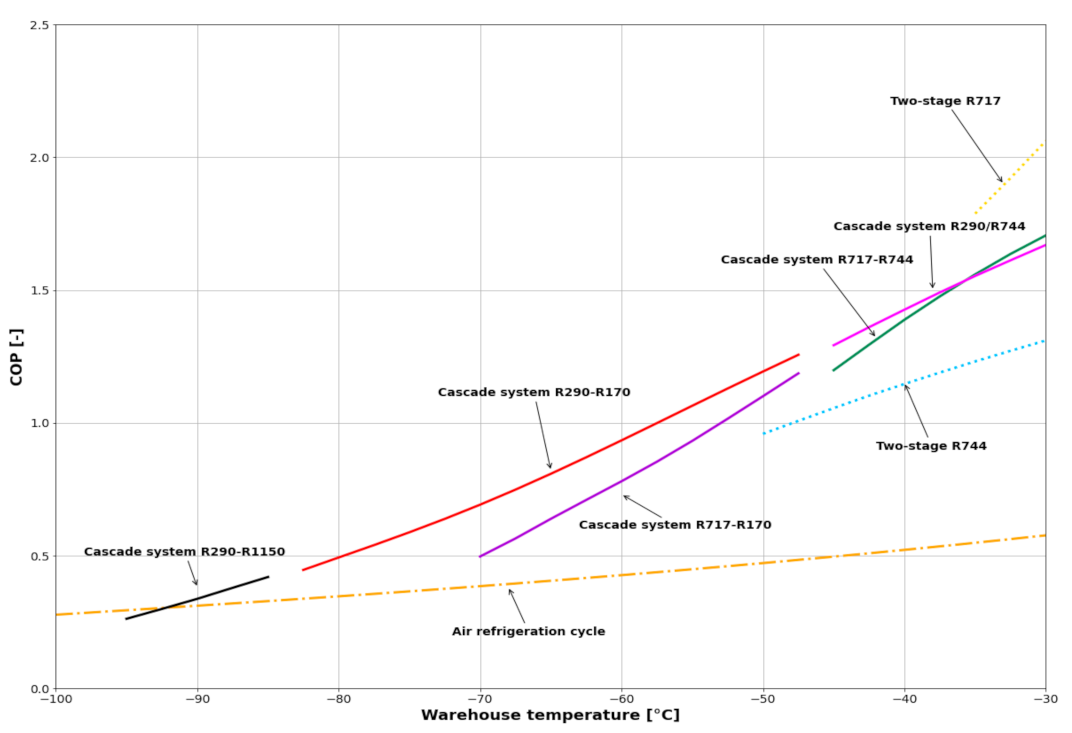
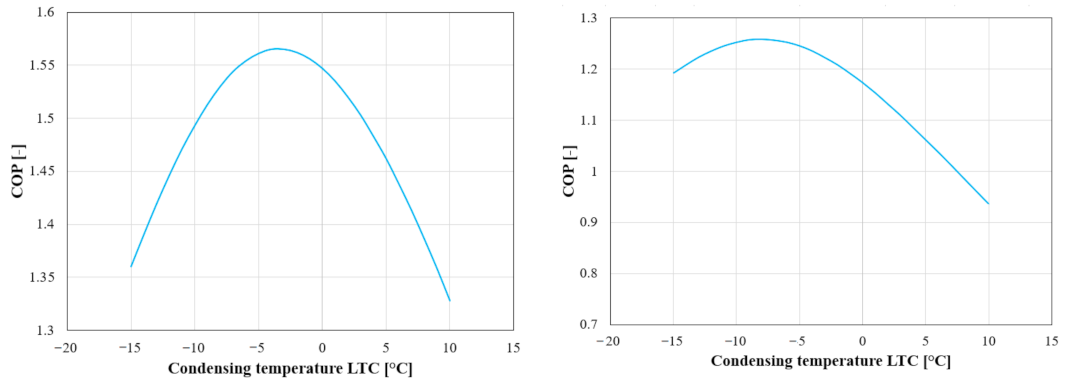

| Refrigerant | Molecular Mass (kg/kmol) | NBP (°C) | Critical Temperature (°C) | Critical Pressure (bar) | ODP | GWP (100 Years) |
|---|---|---|---|---|---|---|
| R-717 | 17 | −33.1 | 132.3 | 113.5 | 0 | 0 |
| R-744 | 44 | −78.5 (−56.6 *) | 31.1 | 73.8 | 0 | 1 |
| Air | 28.9 | −213.4 | −140.7 | 38 | 0 | 0 |
| R-744A | 44 | −88.7 | 36.4 | 72.5 | 0 | 240 |
| Refrigerant | Name | Molecular Mass (kg/kmol) | NBP (°C) | Critical Temperature (°C) | Critical Pressure (bar) | ODP | GWP (100 Years) |
|---|---|---|---|---|---|---|---|
| R-290 | Propane | 44.1 | −42.1 | 96.7 | 42.5 | 0 | 3.3 |
| R-1270 | Propylene | 42.1 | −47.6 | 92.4 | 46.7 | 0 | 1.8 |
| R-170 | Ethane | 30.1 | −88.58 | 32.2 | 48.7 | 0 | 5.5 |
| R-1150 | Ethylene | 28.05 | −103.77 | 9.2 | 50.4 | 0 | 4 |
| Application | Temperature Level | System Requirements | Configurations Investigated |
|---|---|---|---|
| Freezing fish (mackerel, cod) | From ~0 to −40 °C | Space limited, quick freezer, refrigerants according to the country regulations | VRC, MRS, CRS |
| Storage of fish (mackerel, cod) | −40 °C | Proper insulation, stable cooling load, good air flow characteristics | VRC, MRS, CRS, ARC |
| Detector cooling | From −40 to −50 °C | Slow cooling process, limited to refrigerants with resistance to radiation and without any risk in case of leakage | CRS, ARC |
| Freezing fish (tuna) | From −50 to −70 °C | Quick freezing, limited space | MRS, CRS |
| Storage of tuna | −60/−70 °C | Proper insulation, stable cooling load, good air flow characteristics | CRS, ARC |
| Medical applications, vaccine storage | From −60 to −80 °C | Effective cooling process, minimised exposure to external loads, no air infiltrations | ACR, CRS, ARC |
| Cooling of gas | From −30 to −70 °C | Optimisation of the heat transfer process | CRS |
| Application | Fish Freezing (Mackerel, Cod) | |||||
|---|---|---|---|---|---|---|
| System | Primary Refrigerant | Secondary Refrigerant | Evaporating Temperature (°C) | ΔTrefrigerant-air–ΔTair-fish or ΔTrefrigerant–fish (K) | Condensing Temperature (°C) | Type of Freezing System |
| MRS | R717 | −38 | 4–4 | 15 | Air blast freezer | |
| MRS | R744 | −50 | 20 | 15 | Plate freezer | |
| MRS | R744A | −50 | 20 | 15 | Plate freezer | |
| CRS | R717 | R744 | −50 | 20 | 15 | Plate freezer |
| CRS | R290 | R744 | −50 | 20 | 15 | Plate freezer |
| Application | Fish Storage (Mackerel, Cod) | ||||
|---|---|---|---|---|---|
| System | Primary Refrigerant | Secondary Refrigerant | Evaporating Temperature (°C) | (ΔTrefrigerant-R744)–ΔTrefrigerant-air (K) | Condensing Temperature (°C) |
| MRS | R717 | R744 | −40 | 5–5 | 15, 40 |
| MRS | R744 | −35 | 5 | ||
| CRS | R290 | R744 | −35 | 5 | |
| CRS | R717 | R744 | −35 | 5 | |
| CRS | R744 | R744 | −35 | 5 | |
| ARC (open cycle) | Air | Simulation result | ~20 | ||
| Application | Fish Freezing (Tuna) | |||||
|---|---|---|---|---|---|---|
| System | Primary Refrigerant | Secondary Refrigerant | Evaporating Temperature (°C) | Condensing Temperature (°C) | ΔTrefrigerant-air–ΔTair-fish (K) | Type of Freezing Unit |
| CRS | R717, R744, R290, R1270 | R170 | −75 | 15 | 5–10 | Vessel/cold chamber with cold air flow |
| CRS | R717, R744, R290, R1270 | R1150 | −75 | 15 | 5–10 | |
| CRS | R717, R744, R290, R1270 | R744A | −75 | 15 | 5–10 | |
| CRS | R717 | R744 + R170 | −75 | 15 | 5–10 | |
| CRS | R717 | R744 + R1150 | −75 | 15 | 5–10 | |
| Application | Fish Storage (Tuna) | ||||
|---|---|---|---|---|---|
| System | Primary Refrigerant | Secondary Refrigerant | Evaporating Temperature (°C) | ΔTrefrigerant-air (K) | Condensing Temperature (°C) |
| CRS | R744, R290, R1270 | R170 | −65 | 5 | 15, 40 |
| CRS | R744, R290, R1270 | R1150 | −65 | 5 | |
| CRS | R290, R744 | R744+R170 | −65 | 5 | |
| CRS | R290, R744 | R744+R1150 | −65 | 5 | |
| ARC (open cycle) | Air | Simulation result | ~20 | ||
| Application | Vaccine Storage (Pfizer) | ||||
|---|---|---|---|---|---|
| System | Primary Refrigerant | Secondary Refrigerant | Evaporating Temperature (°C) | ΔTrefrigerant-air (K) | Condensing Temperature (°C) |
| ACR | R1150/R600, R1150/R290 | −80 | 5–10 | 15, 30 | |
| ACR | R170/R290, R170/R600,R744/R290 | −80 | 5–10 | ||
| CRS | R744, R290 | R170 | −75 | 5 | 15, 30, 40 |
| CRS | R744, R290 | R1150 | −75 | 5 | |
| CRS | R290, R744 | R744+R170 | −75 | 5 | |
| CRS | R290, R744 | R744+R1150 | −75 | 5 | |
| ARC (open cycle) | Air | Simulation result | ~20 | / | |
Disclaimer/Publisher’s Note: The statements, opinions and data contained in all publications are solely those of the individual author(s) and contributor(s) and not of MDPI and/or the editor(s). MDPI and/or the editor(s) disclaim responsibility for any injury to people or property resulting from any ideas, methods, instructions or products referred to in the content. |
© 2023 by the authors. Licensee MDPI, Basel, Switzerland. This article is an open access article distributed under the terms and conditions of the Creative Commons Attribution (CC BY) license (https://creativecommons.org/licenses/by/4.0/).
Share and Cite
Saeed, M.Z.; Contiero, L.; Blust, S.; Allouche, Y.; Hafner, A.; Eikevik, T.M. Ultra-Low-Temperature Refrigeration Systems: A Review and Performance Comparison of Refrigerants and Configurations. Energies 2023, 16, 7274. https://doi.org/10.3390/en16217274
Saeed MZ, Contiero L, Blust S, Allouche Y, Hafner A, Eikevik TM. Ultra-Low-Temperature Refrigeration Systems: A Review and Performance Comparison of Refrigerants and Configurations. Energies. 2023; 16(21):7274. https://doi.org/10.3390/en16217274
Chicago/Turabian StyleSaeed, Muhammad Zahid, Luca Contiero, Stefanie Blust, Yosr Allouche, Armin Hafner, and Trygve Magne Eikevik. 2023. "Ultra-Low-Temperature Refrigeration Systems: A Review and Performance Comparison of Refrigerants and Configurations" Energies 16, no. 21: 7274. https://doi.org/10.3390/en16217274





